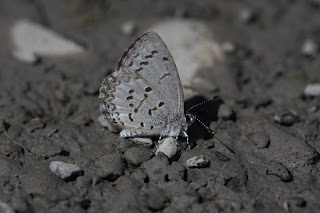One of the most common tree species in eastern Pennsylvania is the Red Maple (Acer rubrum). These common trees of forests, parks, and roadsides begin blooming around the end of March (one of the first trees to flower) and are a sure sign of the start of warmer weather and lengthening days. The flowers range from light orange to dark red.
Skunk Cabbage (Symplocarpus foetidus) is a common plant of wet, swampy areas. During the summer, the large, lettuce-like leaves are easy to spot. However, before the leaves emerge, Skunk Cabbage flowers poke through the leaf litter--representing one of the earliest native spring flowers in this region. These unusual flowers do not even look like what most people would consider a "flower". Keep an eye out for these flowers when visiting a wooded wetland or other area that is permanently wet. The plant displays interesting biochemistry in order to produce heat that not only can melt snow around the plant but serves to volatilize chemicals that give the plant its characteristic (bad) smell. However insects such as flies are apparently attracted to this smell and serve as pollinators for this plant.
Another early spring bloomer is Coltsfoot (Tussilago farfara) a member of the Asteraceae family. This plant is native to Europe and Asia; it was likely brought to this country for medicinal purposes. Despite its use as a cough suppressant and for treatment of asthma, the plant does produce toxic alkaloids. Many people consider this a nuisance (or noxious) weed, but on the slopes of the Kittatinny Ridge, the bright yellow flowers which emerge before the leaves, are a sure sign of spring.
Although butterflies are usually associated with summer, there are a few species that can emerge as early as late March. The first of these is the Mourning Cloak. Unlike many species which overwinter as a caterpillar or migrate, the Mourning Cloak overwinters as an adult butterfly, allowing it to fly around given a stretch of warm weather. This species prefers wooded areas and is often easy to spot. One was already spotted on Friday, February 18th in Cape May, NJ!
 |
| Spring Azure on its host plant lowbush blueberry (Vaccinium pallidum) |
If you see any of the flowers or butterflies mentioned above, leave a comment on this blog post or email phenology@lgnc.org with the sighting information including the species, date, location, weather conditions, your name, contact information, and any other observations or notes that you have.






We have lots of skunk cabbage flowers now here at Bucks County Audubon Society in Solebury. I've been seeing them for about a week now (since the snow pack went down...who knows how long they were there before the snow melted enough to see them!)
ReplyDeleteI suspect that there are other flowers lurking beneath the snow. Skunk cabbage is unique in its being able to generate enough heat to melt some of the surrounding snow!
ReplyDelete